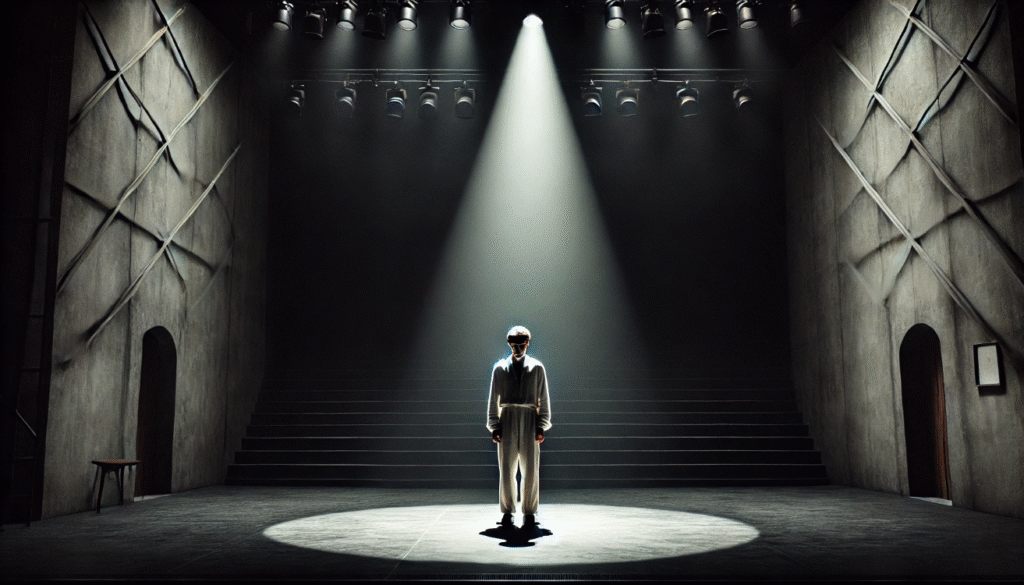Soliloquies are a dramatic device used in literature and drama where a character speaks their thoughts aloud, often revealing their innermost feelings and motivations. One of the most notable practitioners of the effectiveness of soliloquies in storytelling was William Shakespeare, who used this technique in many of his plays, including Hamlet and Macbeth. Historically, soliloquies have played a significant role in drama and literature, as they offer a unique insight into character psychology, advance the plot, and engage the audience. By allowing the audience to hear a character’s inner thoughts and conflicts, soliloquies provide a deeper understanding of the characters and their motivations.
Definition and Origins of Soliloquies:
A soliloquy is a dramatic device in which a character speaks their thoughts aloud, usually while alone on stage. This is different from a monologue, which is a lengthy speech by one character, often addressed to other characters, and asides, which are brief comments made by a character to the audience, not heard by other characters on stage. The use of soliloquies can be traced back to Greek and Roman drama, where they were used to convey a character’s inner thoughts and feelings to the audience. In the Renaissance period, soliloquies became more prominent in plays, with notable examples in works such as Shakespeare’s Hamlet and Macbeth.
Key Functions of Soliloquies in Storytelling:
Character Insight:

The effectiveness of soliloquies in storytelling are an important dramatic device used in plays to reveal the inner thoughts, emotions, and motivations of characters. The effectiveness of soliloquies in storytelling provide a window into the character’s mind, allowing the audience to gain a deeper understanding of their inner turmoil and conflicts. In Shakespeare’s Hamlet, the titular character delivers several The effectiveness of soliloquies in storytelling that reveal his inner struggle with indecision, grief, and anger. In his famous “To be or not to be” soliloquy, Hamlet reflects on the nature of existence and the torment of his internal turmoil. The effectiveness of soliloquies in storytelling, the audience gains insight into Hamlet’s complex emotions and motivations, shedding light on his actions throughout the play.
Plot Advancement:
Soliloquies are an important literary device in plays and literature, as they provide key plot details and foreshadow events. They are a way for a character to express their inner thoughts and feelings to the audience, providing insight into their motivations and intentions. This can help drive the story forward and create tension and suspense. One specific example of how soliloquies drive the story forward is in Shakespeare’s “Hamlet.” In the famous “To be or not to be” soliloquy, Hamlet expresses his inner turmoil and indecision about whether to live or die. This soliloquy reveals Hamlet’s internal struggle and foreshadows his eventual descent into madness.
Thematic Exploration:
such as ambition, love, and mortality. Through soliloquies, characters are able to express their innermost thoughts and feelings, providing insight into their motivations and struggles. One famous example of this is the soliloquy “To be or not to be” from Shakespeare’s Hamlet. In this soliloquy, Hamlet grapples with the idea of mortality, contemplating the value of life and the fear of the unknown. This soliloquy delves into the theme of mortality, as Hamlet questions the purpose of existence and ponders the idea of death. Similarly, soliloquies can also explore the theme of ambition.
Soliloquies and Audience Engagement:
Soliloquies in literature and theater serve as a unique way for a character to directly communicate their innermost thoughts and feelings to the audience. By breaking the fourth wall and speaking directly to the audience, a character can establish an intimate and personal connection with the viewers or readers. This allows for a deeper understanding of the character’s motivations, fears, and desires, creating a sense of empathy and emotional investment from the audience. Soliloquies also provide insight into the character’s internal struggles, allowing the audience to connect with them on a more personal level. This unique relationship established through soliloquies helps to maintain the audience’s emotional investment in the story and the characters, ultimately enhancing the overall experience of the performance or literary work.
The Dramatic Power of Language in Soliloquies:

The use of poetic and rhetorical devices in soliloquies enhances their effectiveness by adding layers of emotion, imagery, and depth to the character’s inner thoughts and struggles. Shakespeare’s mastery of language in his soliloquies is evident in his ability to evoke powerful emotions and create vivid imagery through the use of metaphors, similes, alliteration, and other literary devices. For example, in Hamlet’s famous “To be, or not to be” soliloquy, Shakespeare uses metaphors such as “the slings and arrows of outrageous fortune” to convey the character’s inner turmoil and existential questioning.
The Psychological Depth of Soliloquies:
Soliloquies are a powerful tool used in literature and drama to explore the internal conflicts and dilemmas of characters. By allowing characters to speak their thoughts aloud, soliloquies provide insight into their inner struggles and complexities. Through soliloquy-driven storytelling, playwrights can portray multifaceted personalities and showcase the depth of their characters. This technique allows the audience to gain a deeper understanding of the internal turmoil, doubts, and moral dilemmas that the characters face. For example, in Shakespeare’s play Othello, the soliloquies of the protagonist reveal his inner conflict as he grapples with jealousy, insecurity, and betrayal.
The Evolution of Soliloquies in Modern Storytelling:

Soliloquies have had a significant impact on modern narrative techniques, particularly in the use of voice-overs in films. Soliloquies, which originated in classical theater as a dramatic device for a character to express their inner thoughts and emotions directly to the audience, have influenced the use of voice-overs in cinema to provide insight into a character’s internal dialogue and motivations. In modern cinema and television, soliloquy-like techniques can be seen in various forms, such as characters speaking directly to the camera, inner monologues, and voice-overs that reveal a character’s thoughts and feelings.
Case Studies of Famous Soliloquies:
In Shakespeare’s plays, soliloquies serve as a powerful tool for character development and storytelling. Let’s take a closer look at a few notable soliloquies from Hamlet, Macbeth, and Richard III and analyze how each achieves its narrative and emotional goals. In Hamlet, the famous “To be or not to be” soliloquy showcases the protagonist’s inner turmoil and contemplation of life and death. The soliloquy serves to deepen the audience’s understanding of Hamlet’s existential crisis and his struggle with indecision. Through this introspective monologue, Shakespeare effectively conveys the complexity of Hamlet’s character and his internal conflict, adding depth and emotional resonance to the narrative.
The Effectiveness of Soliloquies in Storytelling:
Soliloquies have the unique strength of providing insight into a character’s inner thoughts and emotions, allowing the audience to connect with the character on a deeper level. This technique also serves to advance the plot and reveal important information that may not be conveyed through dialogue or action alone. By directly addressing the audience, soliloquies create a sense of intimacy and immediacy, drawing the audience into the character’s world and creating a powerful narrative experience. Soliloquies remain a timeless storytelling technique because they offer a direct window into the human experience. The exploration of a character’s inner thoughts and struggles is a universal theme that transcends time and culture, allowing audiences to empathize with and understand the complexities of human nature.
Soliloquies in storytelling serve as a powerful tool for allowing characters to express their inner thoughts and emotions to the audience. They provide insight into a character’s motivations, fears, and desires, and can be used to build tension, reveal important plot points, or develop a character’s arc. The enduring relevance of soliloquies in modern narratives is evident in their continued use in literature, theater, film, and television. From Shakespearean plays to contemporary dramas, soliloquies remain a compelling and effective way to connect audiences with the inner lives of characters. The artistry and emotional power of soliloquies lie in their ability to create a sense of intimacy and connection between the character and the audience.













